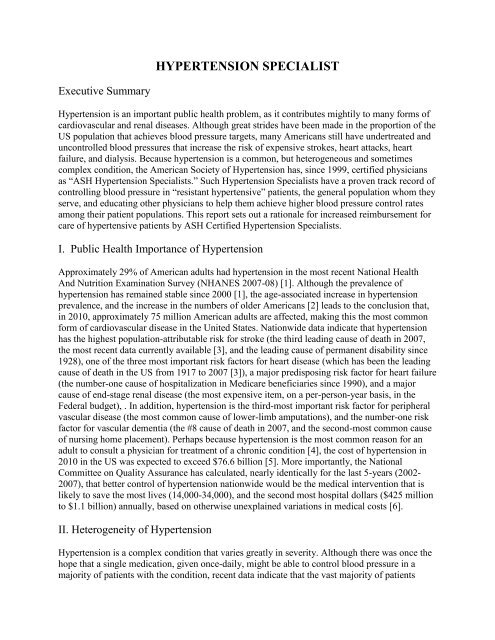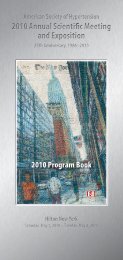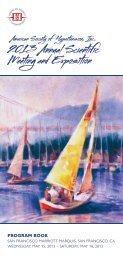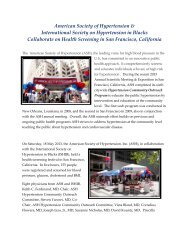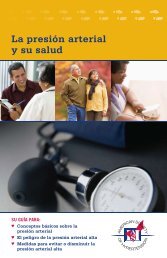HYPERTENSION SPECIALIST - American Society of Hypertension
HYPERTENSION SPECIALIST - American Society of Hypertension
HYPERTENSION SPECIALIST - American Society of Hypertension
You also want an ePaper? Increase the reach of your titles
YUMPU automatically turns print PDFs into web optimized ePapers that Google loves.
<strong>HYPERTENSION</strong> <strong>SPECIALIST</strong><br />
Executive Summary<br />
<strong>Hypertension</strong> is an important public health problem, as it contributes mightily to many forms <strong>of</strong><br />
cardiovascular and renal diseases. Although great strides have been made in the proportion <strong>of</strong> the<br />
US population that achieves blood pressure targets, many <strong>American</strong>s still have undertreated and<br />
uncontrolled blood pressures that increase the risk <strong>of</strong> expensive strokes, heart attacks, heart<br />
failure, and dialysis. Because hypertension is a common, but heterogeneous and sometimes<br />
complex condition, the <strong>American</strong> <strong>Society</strong> <strong>of</strong> <strong>Hypertension</strong> has, since 1999, certified physicians<br />
as “ASH <strong>Hypertension</strong> Specialists.” Such <strong>Hypertension</strong> Specialists have a proven track record <strong>of</strong><br />
controlling blood pressure in “resistant hypertensive” patients, the general population whom they<br />
serve, and educating other physicians to help them achieve higher blood pressure control rates<br />
among their patient populations. This report sets out a rationale for increased reimbursement for<br />
care <strong>of</strong> hypertensive patients by ASH Certified <strong>Hypertension</strong> Specialists.<br />
I. Public Health Importance <strong>of</strong> <strong>Hypertension</strong><br />
Approximately 29% <strong>of</strong> <strong>American</strong> adults had hypertension in the most recent National Health<br />
And Nutrition Examination Survey (NHANES 2007-08) [1]. Although the prevalence <strong>of</strong><br />
hypertension has remained stable since 2000 [1], the age-associated increase in hypertension<br />
prevalence, and the increase in the numbers <strong>of</strong> older <strong>American</strong>s [2] leads to the conclusion that,<br />
in 2010, approximately 75 million <strong>American</strong> adults are affected, making this the most common<br />
form <strong>of</strong> cardiovascular disease in the United States. Nationwide data indicate that hypertension<br />
has the highest population-attributable risk for stroke (the third leading cause <strong>of</strong> death in 2007,<br />
the most recent data currently available [3], and the leading cause <strong>of</strong> permanent disability since<br />
1928), one <strong>of</strong> the three most important risk factors for heart disease (which has been the leading<br />
cause <strong>of</strong> death in the US from 1917 to 2007 [3]), a major predisposing risk factor for heart failure<br />
(the number-one cause <strong>of</strong> hospitalization in Medicare beneficiaries since 1990), and a major<br />
cause <strong>of</strong> end-stage renal disease (the most expensive item, on a per-person-year basis, in the<br />
Federal budget), . In addition, hypertension is the third-most important risk factor for peripheral<br />
vascular disease (the most common cause <strong>of</strong> lower-limb amputations), and the number-one risk<br />
factor for vascular dementia (the #8 cause <strong>of</strong> death in 2007, and the second-most common cause<br />
<strong>of</strong> nursing home placement). Perhaps because hypertension is the most common reason for an<br />
adult to consult a physician for treatment <strong>of</strong> a chronic condition [4], the cost <strong>of</strong> hypertension in<br />
2010 in the US was expected to exceed $76.6 billion [5]. More importantly, the National<br />
Committee on Quality Assurance has calculated, nearly identically for the last 5-years (2002-<br />
2007), that better control <strong>of</strong> hypertension nationwide would be the medical intervention that is<br />
likely to save the most lives (14,000-34,000), and the second most hospital dollars ($425 million<br />
to $1.1 billion) annually, based on otherwise unexplained variations in medical costs [6].<br />
II. Heterogeneity <strong>of</strong> <strong>Hypertension</strong><br />
<strong>Hypertension</strong> is a complex condition that varies greatly in severity. Although there was once the<br />
hope that a single medication, given once-daily, might be able to control blood pressure in a<br />
majority <strong>of</strong> patients with the condition, recent data indicate that the vast majority <strong>of</strong> patients
equire two or more medications to achieve and maintain blood pressure control (traditionally<br />
defined as blood pressure < 140/90 mm Hg). Recent national and international expert panels<br />
have recommended that high-risk hypertensive patients (e.g., those with diabetes [7], chronic<br />
kidney disease [8], and established heart disease [9]) should have their blood pressures controlled<br />
to even lower thresholds (typically < 130/80 mm Hg, although even lower targets have been<br />
proposed for some <strong>of</strong> these very high-risk groups).<br />
III. Challenges in <strong>Hypertension</strong><br />
Approximately 15% <strong>of</strong> people with hypertension are considered “resistant” (blood pressure<br />
remains elevated despite prescription <strong>of</strong> at least 3 properly-chosen medications [10]). Patients<br />
with this condition are challenging to diagnose and treat, and are <strong>of</strong>ten referred by primary care<br />
physicians (including cardiologists, nephrologists, endocrinologists, and other medical<br />
subspecialists) to physicians who have special knowledge and expertise in the field <strong>of</strong><br />
hypertension (“<strong>Hypertension</strong> Specialists”).<br />
Although the vast majority <strong>of</strong> patients with hypertension have no known cause for their condition<br />
(so-called “primary hypertension”), about 5% <strong>of</strong> the hypertensive US population do have a<br />
secondary cause for their condition. Because people with a secondary cause typically need<br />
special attention, either because the cause is (by definition) uncommon, or because the blood<br />
pressure responds only to an intervention specific to each secondary cause <strong>of</strong> hypertension, these<br />
patients are <strong>of</strong>ten referred to a <strong>Hypertension</strong> Specialist, for further evaluation and management <strong>of</strong><br />
their secondary cause <strong>of</strong> hypertension.<br />
IV. Limited Supply <strong>of</strong> <strong>Hypertension</strong> Specialists<br />
There are currently less than 1,500 physicians who have become certified as <strong>Hypertension</strong><br />
Specialists by meeting the specified criteria (outlined below) and passing the examination given<br />
by the <strong>American</strong> <strong>Society</strong> <strong>of</strong> <strong>Hypertension</strong>’s Specialist Program. Thus, it is apparent that to meet<br />
the nationwide demand for these physicians’ services in caring for patients with complex,<br />
resistant, or secondary hypertension, many more <strong>Hypertension</strong> Specialists will be required.<br />
Because <strong>of</strong> the important role that these <strong>Hypertension</strong> Specialists can, do, and will play in the<br />
prevention <strong>of</strong> adverse cardiovascular and renal disease outcomes, it is necessary to describe the<br />
current criteria for the designation <strong>of</strong> “Specialist in Clinical <strong>Hypertension</strong>.”<br />
V. Current criteria for the designation <strong>of</strong> “Specialist in Clinical <strong>Hypertension</strong>”<br />
<br />
<br />
<br />
<br />
Medical degree (MD, DO, or equivalent) and unrestricted license to practice medicine<br />
Specialty Board Certification in a discipline recognized by the <strong>American</strong> Board <strong>of</strong><br />
Medical Specialties (Internal Medicine, Cardiology, Nephrology, Endocrinology, Family<br />
Medicine, Pediatrics, Obstetrics/Gynecology, etc.)<br />
Competent in all modalities involved in the diagnosis and treatment <strong>of</strong> hypertension<br />
Passed the examination produced and <strong>of</strong>fered by the <strong>American</strong> <strong>Society</strong> <strong>of</strong> <strong>Hypertension</strong>’s<br />
Specialist Program.
VI. Clinical Function <strong>of</strong> <strong>Hypertension</strong> Specialist<br />
It is expected, based on current standards and practices, that a majority (at least 50%) <strong>of</strong> the<br />
<strong>Hypertension</strong> Specialist’s clinical time and effort will be devoted to care <strong>of</strong> patients with<br />
hypertension and related disorders. The major activities that the physician is likely to be involved<br />
include, but are not limited to,<br />
A. Referral destination for difficult to manage (“resistant”) hypertension<br />
B. Referral destination for investigation for secondary causes <strong>of</strong> hypertension<br />
C. Referral destination for investigation <strong>of</strong> White Coat and Masked HTN<br />
D. Referral destination for assessment <strong>of</strong> global cardiovascular and renal risk using<br />
sophisticated techniques<br />
E. Serves as community resource for hypertension and related disorders, e.g., formulary<br />
committees, credentialing committees, training programs, medical insurance companies,<br />
outreach programs<br />
F. Referral destination for integrating lifestyle modifications in hypertension treatment<br />
strategies<br />
VII. Impact <strong>of</strong> the <strong>Hypertension</strong> Specialist in “Resistant <strong>Hypertension</strong>”<br />
Although there are no randomized clinical trials examining the quality <strong>of</strong> care <strong>of</strong> hypertensive<br />
patients delivered by <strong>Hypertension</strong> Specialists vs. other physicians, a body <strong>of</strong> evidence indicates<br />
that <strong>Hypertension</strong> Specialists excel in controlling blood pressure and other cardiovascular risk<br />
factors. This is particularly true for patients with “resistant hypertension.” One report from the<br />
Cleveland Clinic indicates that 95% <strong>of</strong> such patients at that institution received an appropriate<br />
diagnosis after a suitable, but limited evaluation [11]. A much earlier report from the Yale<br />
University <strong>Hypertension</strong> Center indicated that, in 91 patients with resistant hypertension (who by<br />
definition had uncontrolled blood pressure when first seen by the <strong>Hypertension</strong> Specialist at that<br />
Center), a specific diagnosis was made in 91%, and “blood pressure control” was achieved in<br />
53% [12]. A more recent report from the RUSH University <strong>Hypertension</strong> Center included 141<br />
such patients; 94% received a specific diagnosis for their “resistant hypertension,” and 53% had<br />
their blood pressures brought under control (< 140/90 mm Hg) [13]. These two reports are<br />
particularly important, as one <strong>of</strong> the entry criteria for each study was that all patients had failed<br />
to achieve blood pressure control when seen by at least one other physician; many were referred<br />
to these <strong>Hypertension</strong> Specialists after consultation with more than one physician, many <strong>of</strong><br />
whom were cardiologists, nephrologists, endocrinologists, or other medical subspecialists. The<br />
fact that 53% <strong>of</strong> these patients achieved controlled blood pressure, sometimes after even a single<br />
visit to a <strong>Hypertension</strong> Specialist, highlights the high cost-effectiveness <strong>of</strong> such referrals, and the<br />
wisdom <strong>of</strong> such referrals. One randomized controlled study compared the care <strong>of</strong> a <strong>Hypertension</strong><br />
Specialist with changes to an antihypertensive regimen suggested by a more intensive (and<br />
expensive) testing using a bioimpedance device in 104 resistant hypertensive patients at The<br />
Mayo Clinic. The proportion <strong>of</strong> patients achieving blood pressure control (≤ 140/90 mm Hg)<br />
after 3 months was significantly different (P< 0.05) between the two groups: 56% for the tested<br />
group, vs. 33% for those seen by <strong>Hypertension</strong> Specialists [14]. This result is likely to have been<br />
confounded by the 13 excluded subjects, the high proportion (34%) <strong>of</strong> secondary causes that<br />
were identified but not addressed during follow-up (at the patient’s request), and the fact that all<br />
119 eligible patients were seen by a <strong>Hypertension</strong> Specialist before randomization to either
group (to make it more likely that a suboptimal drug regimen was responsible for their<br />
“resistance.” Other groups have not been as successful in using such a device to modify an<br />
antihypertensive drug regimen in patients with resistant hypertension, suggesting that a<br />
<strong>Hypertension</strong> Specialist may be able to control blood pressure very well, without wasting more<br />
time or money on expensive testing.<br />
VIII. Impact <strong>of</strong> the <strong>Hypertension</strong> Specialist in Controlling Blood Pressure (and<br />
other cardiovascular risk factors) in Patient Populations Served<br />
Several preliminary reports have suggested that <strong>Hypertension</strong> Specialists are expert not only at<br />
controlling blood pressure, but also other cardiovascular risk factors, in their populations <strong>of</strong><br />
patients. Annual chart reviews at the RUSH University <strong>Hypertension</strong> Center (staffed by 3 or<br />
more <strong>Hypertension</strong> Specialists) were performed from 2001-2007 to assess the proportion <strong>of</strong> its<br />
patients who achieved “controlled blood pressure” (< 140/90 mm Hg, the standard used by the<br />
National Health And Nutrition Examination Surveys, NHANES) [15-23]. The results are shown<br />
as the dark bars (compared to the dark horizontal line, representing the national prevalence <strong>of</strong><br />
controlled hypertension in NHANES) in Figure 1. At all time points studied, the prevalence <strong>of</strong><br />
controlled hypertension was about double that <strong>of</strong> the general hypertensive population. This result<br />
is all the more remarkable because more than half <strong>of</strong> the patient population in this <strong>Hypertension</strong><br />
Center was referred by other physicians because <strong>of</strong> inadequate blood pressure control in their<br />
<strong>of</strong>fices.<br />
80<br />
70<br />
BP < 140/90 mm Hg<br />
LDL-cholesterol < NCEP Target<br />
A1c < 7%<br />
60<br />
50<br />
40<br />
30<br />
NHANES<br />
BP < 140/90<br />
20<br />
10<br />
0<br />
1997 1999 2001 2002 2003 2004 2005 2006<br />
Year <strong>of</strong> Survey (A.D.)<br />
2007
Figure 1. Prevalence <strong>of</strong> controlled cardiovascular risk factors in one <strong>Hypertension</strong> Clinic staffed<br />
by <strong>Hypertension</strong> Specialists. The vertical bars represent the prevalence <strong>of</strong> “controlled<br />
hypertension” (< 140/90 mm Hg, as used by the National Health And Nutritional Examination<br />
Surveys, NHANES) in chart reviews <strong>of</strong> the population served by the <strong>Hypertension</strong> Specialists.<br />
The horizontal lines represent the prevalence <strong>of</strong> “controlled hypertension” in the national survey<br />
(NHANES).<br />
Similar, albeit less frequent, surveys <strong>of</strong> all charts corresponding to patients seen at that<br />
<strong>Hypertension</strong> Center were also reported for control <strong>of</strong> other cardiovascular risk factors (e.g., lowdensity<br />
lipoprotein [LDL]-cholesterol, A1c levels in diabetics, etc.) [24-26]. These are shown as<br />
stippled bars and horizontal lines in Figure 1. Again, the proportion <strong>of</strong> patients seen by<br />
<strong>Hypertension</strong> Specialists in the <strong>Hypertension</strong> Center who achieved their targets for these<br />
cardiovascular risk factors was twice to three-times that seen in the general US population, as<br />
reported by NHANES. These data indicate that <strong>Hypertension</strong> Specialists excel not only at<br />
controlling blood pressure, but also other modifiable cardiovascular risk factors that are<br />
amenable to treatment.<br />
IX. Impact <strong>of</strong> the <strong>Hypertension</strong> Specialist Outreach Program in Improving Blood<br />
Pressure Control in Patient Populations<br />
Since 1999, the <strong>American</strong> <strong>Society</strong> <strong>of</strong> <strong>Hypertension</strong>’s Registry Initiative, a program initiated by<br />
the ASH Carolinas, Florida and Georgia Regional Chapter—based at the Medical University <strong>of</strong><br />
South Carolina—has enrolled community-based medical practices in a quality improvement<br />
program, based on practice data, audit and feedback reporting. This framework <strong>of</strong>fers the<br />
capability: (a) to reveal areas <strong>of</strong>, and reasons for, high and low hypertension control rates; and<br />
(b) to track physician prescribing patterns, “therapeutic inertia” [27], (technical term for the<br />
reluctance <strong>of</strong> physicians and other healthcare providers to intensify antihypertensive treatment<br />
when faced with a patient who is NOT at or below goal blood pressure), frequency <strong>of</strong> key<br />
laboratory tests, and the control <strong>of</strong> hypertension, dyslipidemia and/or diabetes in their patients.<br />
The <strong>American</strong> <strong>Society</strong> <strong>of</strong> <strong>Hypertension</strong> (ASH) is committed to quality improvement initiatives,<br />
improving hypertension outcomes and to serving as the agent for change in modifiable<br />
cardiovascular risk factors. The data collection protocol developed by the ASH Carolinas,<br />
Florida and Georgia Chapter’s <strong>Hypertension</strong> Initiative <strong>of</strong>fers the capability to accomplish these<br />
objectives, and plans for its adoption by other regional ASH Chapters are currently underway.<br />
The process and outcomes for the ASH Registry Initiative includes a HIPPA (Health Information<br />
Portability and Accountability Act)-compliant mechanism for recording and tracking individual<br />
patients in a physician’s practice, so that quarterly “dashboard report cards” can be generated for<br />
each physician regarding control rates (using established NCQA/PQRI) indicators (blood<br />
pressures
(cited above). Providers can securely access a list <strong>of</strong> their patients who have uncontrolled risk<br />
factors, haven’t been seen in the past 6-months, or haven’t had the recommended laboratory tests<br />
performed in the prior year. The ASH Registry Initiative currently covers more than 1.5 million<br />
unique patients, and is expected to increase in size over the next few years, as the ASH Midwest<br />
Chapter (and potentially other Regional Chapters) join in the effort. ASH is currently considering<br />
proposals to extend enrollment in the <strong>Hypertension</strong> Initiative to all other ASH Regional Chapters<br />
nationwide, which has the potential to easily double the numbers <strong>of</strong> included patients and<br />
providers.<br />
Successes <strong>of</strong> the ASH Registry Initiative include: 1) Improving blood pressure control in<br />
208,517 hypertensive patients over a 5-year period from 49% in 2000 to 66% in 2005 [28],<br />
which exceeded the improvement observed in the general U.S. population [1]. 2) Control in<br />
82,442 diabetics (to an A1c <strong>of</strong>
the ASH Carolinas, Florida and Georgia Chapters, which links very well with the Registry<br />
Initiative described above. In this program, <strong>Hypertension</strong> Specialists engage in Continuing<br />
Medical Education activities, sponsored by the <strong>American</strong> <strong>Society</strong> <strong>of</strong> <strong>Hypertension</strong>, which have<br />
as their purpose the improvement <strong>of</strong> blood pressure (and other cardiovascular risk factor) control<br />
rates in the patients seen by the attendees at the educational activities. Preliminary data from<br />
these programs show that the attendees at the programs are quite likely to join the <strong>Hypertension</strong><br />
Initiative, to report their data in a timely fashion, and to show a significant improvement in<br />
control rates, not only for blood pressure, but also for other cardiovascular risk factors. These<br />
data, albeit preliminary, have been sufficient for Blue Cross/Blue Shield <strong>of</strong> South Carolina to<br />
provide a one-time payment <strong>of</strong> $5000.00 for every physician who becomes an ASH-Certified<br />
<strong>Hypertension</strong> Specialist. The fact that the newly-Certified physician is likely to join the<br />
educational program, and to educate other healthcare providers to emulate his/her efforts to<br />
improve cardiovascular risk factor control, is but an extension <strong>of</strong> the obvious benefit <strong>of</strong> having<br />
such ASH-Certified <strong>Hypertension</strong> Specialists in the community. Not only do they control their<br />
patient populations’ cardiovascular risk factors better than their non-Certified colleagues, but<br />
they also pass on information on how to achieve these better levels <strong>of</strong> control to other colleagues<br />
as part <strong>of</strong> the educational programs [40].<br />
X. Specific Responses to Requests from Pamela R. West, PT, DPT, MPH; Health<br />
Insurance Specialist; Division <strong>of</strong> Practitioner Services; Centers for Medicare and<br />
Medicaid Services on 07 May 2010 at 11:13 AM (EDT)<br />
1. The primary purpose or reason for the development <strong>of</strong> a specialty code for hypertension<br />
specialists is, as indicated above, to recognize the specialized knowledge, experience, and<br />
skills <strong>of</strong> the hypertension specialist.<br />
2. The practice pattern for hypertension specialists differs from those <strong>of</strong> other primary care<br />
parent specialties, as reflected in the different patient populations they serve. In general,<br />
patients seen by hypertension specialists have a greater severity <strong>of</strong> hypertension, take a larger<br />
number <strong>of</strong> antihypertensive and other prescribed therapies, have more target-organ damage<br />
and more advanced cardiovascular and renal disease, and far more commonly have<br />
“uncontrolled” blood pressures. <strong>Hypertension</strong> specialists are experts in the transformation <strong>of</strong><br />
“resistant” or “refractory” hypertensive patients into “controlled hypertensive” patients.<br />
3. The percentage <strong>of</strong> Medicare patients that are treated by <strong>Hypertension</strong> Specialists is unknown.<br />
To address this, an e-mailed survey was recently sent to all 1324 <strong>Hypertension</strong> Specialists<br />
residing in the US; the response rate was 21%. On average, each <strong>Hypertension</strong> Specialist<br />
reports seeing 135 (interquartile range: 188) Medicare beneficiaries with complex or resistant<br />
hypertension annually. These data suggest that currently, <strong>Hypertension</strong> Specialists see about<br />
179,000 Medicare beneficiaries with complex or resistant hypertension annually (0.4% <strong>of</strong> the<br />
Medicare population). Conservative projections <strong>of</strong> existing data suggest that, if a mechanism<br />
existed (e.g., a specialty code for <strong>Hypertension</strong> Specialists) to refer these patients to<br />
<strong>Hypertension</strong> Specialists, 2.5-3.4 million Medicare beneficiaries could achieve controlled<br />
blood pressure [41].
4. As noted above, ASH <strong>Hypertension</strong> Specialists are not currently recognized as such by the<br />
<strong>American</strong> Board <strong>of</strong> Medical Specialties (for MDs) or the <strong>American</strong> Osteopathic Association<br />
(for DOs). All ASH <strong>Hypertension</strong> Specialists are, however, Board-Certified in at least one<br />
primary care specialty, as recognized by the <strong>American</strong> Board <strong>of</strong> Medical Specialties or the<br />
<strong>American</strong> Osteopathic Association. As noted above, this is a requirement for consideration as<br />
an ASH-Certified <strong>Hypertension</strong> Specialist. In addition, the <strong>American</strong> <strong>Society</strong> <strong>of</strong><br />
<strong>Hypertension</strong> has ongoing relationships with most other pr<strong>of</strong>essional organizations involved<br />
in Continuing Medical Education activities that would be expected to be <strong>of</strong> joint interest. For<br />
example, ASH has sponsored and accredited symposia for Continuing Medical Education at<br />
recent national or regional meetings <strong>of</strong> the <strong>American</strong> Heart Association, <strong>American</strong> College <strong>of</strong><br />
Cardiology, <strong>American</strong> <strong>Society</strong> <strong>of</strong> Nephrology, as well as other pr<strong>of</strong>essional organizations.<br />
5. On February 26, 2009 at 3:50 PM, ASH formally requested that the National Uniform Claims<br />
Committee (NUCC) develop a healthcare taxonomy code specifically for ASH-Certified<br />
<strong>Hypertension</strong> Specialists. ASH was notified on April 09, 2009 at 2:14 PM, that this request<br />
was denied by NUCC.<br />
XI. Summary<br />
Collectively, these data make it likely that ASH-Certified <strong>Hypertension</strong> Specialists should<br />
enhance cardiovascular risk factor control rates, not just among the patients they see with<br />
“resistant hypertension,” but also in their populations as a whole. In addition, ASH-Certified<br />
<strong>Hypertension</strong> Specialists have had, and are likely to continue to exert, a salutary effect on other<br />
healthcare providers in their local areas, who follow the lead <strong>of</strong> the ASH-Certified <strong>Hypertension</strong><br />
Specialist in improving cardiovascular risk factor control in the short-term, and probably<br />
cardiovascular outcomes in the long-term. Such efforts should be rewarded with a specialist code<br />
for hypertension specialists.<br />
References<br />
1. Egan BM, Zhao Y, Axon RN. US trends in prevalence, awareness, treatment and control <strong>of</strong><br />
hypertension, 1988-2008. JAMA. 2010;303:2043-2051.<br />
2. Projected Population <strong>of</strong> the United States, by Age and Sex: 2000 to 2050. US Census Bureau.<br />
Available on the Internet at:<br />
http://www.census.gov/populatin/www/projections/usinterimprog/, accessed 27 SEP 10.<br />
3. Xu J, Kochanek KD, Murphy SL, Tejada-Vera B. Deaths: Final data for 2007. National Vital<br />
Statistics Reports. 2010:58:1-135. Available on the Internet at:<br />
http://www.cdc.gov/nchs/data/nvsr/nvsr58/nvsr58_19..pdf, accessed 27 SEP 10.<br />
4. Fang J, Alderman MH, Keenan NL, Ayala C, Cr<strong>of</strong>t JB. <strong>Hypertension</strong> control at physicians'<br />
<strong>of</strong>fices in the United States. Am J Hypertens. 2008;21:136–142.<br />
5. Lloyd-Jones D, Adams RJ, Brown TM, et al. Heart Disease and Stroke Statistics—2010<br />
Update. AHA Statistical Update: A report from the <strong>American</strong> Heart Association. Circulation.<br />
2010;121:e46-e215.
6. Table 10, in: National Committee for Quality Assurance. State <strong>of</strong> Health Care Quality. 2007,<br />
Available at: http://www.web.ncqa.org/Portals/0/Newsroom/SOHC/SOHC_07.pdf, accessed<br />
01 JUL 10.<br />
7. <strong>American</strong> Diabetes Association. Standards <strong>of</strong> medical care in diabetes—2010. Diabetes<br />
Care. 2010;33 (Suppl. 1):S13-61, especially pages S28-S29.<br />
8. Levey AS, Rocco MV, Anderson S, et al. K/DOQI Clinical Practice Guidelines on<br />
<strong>Hypertension</strong> and Antihypertensive Agents in Chronic Kidney Disease. Am J Kidney Dis.<br />
2004;43 (Suppl. 1):S1-S290.<br />
9. Rosendorff C, Black HR, Cannon CP, et al. Treatment <strong>of</strong> hypertension in the prevention and<br />
management <strong>of</strong> ischemic heart disease. A Scientific Statement from the <strong>American</strong> Heart<br />
Association Council for High Blood Pressure Research and the Councils on Clinical<br />
Cardiology and Epidemiology and Prevention. Circulation. 2007;115:2761-2788.<br />
10. Moser M, Setaro JF. Refractory or difficult-to-control hypertension. N Engl J Med.<br />
2006;355:385-392.<br />
11. Vidt DG. Contributing factors in resistant hypertension. Truly refractory disease is rarely<br />
found in a properly-conducted workup. Postgrad Med. 2000;107:57-60.<br />
12. Yakovlevitch M, Black HR. Resistant hypertension in a tertiary care clinic. Arch Intern Med.<br />
1991;151:1786-1792.<br />
13. Garg JP, Elliott WJ, Folker A, Izhar M, Black HR, for the RUSH University <strong>Hypertension</strong><br />
Service. Resistant hypertension revisited: A comparison <strong>of</strong> two university-based cohorts. Am<br />
J Hypertens. 2005;18:619-626.<br />
14. Taler SJ, Textor SC, Augustine JE. Resistant hypertension: Comparing hemodynamic<br />
management to specialist care. <strong>Hypertension</strong>. 2002;39:982-988.<br />
15. Odama U, Singer G, Morrissey M, Elliott WJ, Black HR. Predictors <strong>of</strong> hypertension control<br />
in a specialty clinic [abstract]. Am J <strong>Hypertension</strong>. 2000;13:19A.<br />
16. Izhar M, Elliott WJ, Singer G, Sharma N, Bakris GL, Neri GS, Black HR. Prevalence and<br />
control <strong>of</strong> cardiovascular risk factors in a tertiary hypertension clinic [abstract]. Am J<br />
Hypertens. 2001;14:247A.<br />
17. Garg JP, Elliott WJ, M. Izhar M, Neri GS, Bakris GL, Black HR. Lack <strong>of</strong> performancerelated<br />
bias in blood pressure measurements in a hypertension clinic [abstract]. Am J<br />
Hypertens. 2002;15:A91.<br />
18. Ellis R, Elliott WJ, Izhar M, Pandey D, Hasabou N, Bakris GL, Black HR. Medication<br />
utilization to achieve goal blood pressure in a tertiary hypertension clinic [abstract]. Am J<br />
Hypertens. 2003;16:34A.<br />
19. Chua DY, Behara R, Meyer P, Karavolas K, Black HR, Elliott WJ. Prevalence <strong>of</strong><br />
antihypertensive drug monotherapy at a specialty hypertension clinic [abstract]. Am J<br />
Hypertens. 2004;17:103A.<br />
20. Choi KL, Bakris GL, Black HR, Neri GS, Elliott WJ. Predictors <strong>of</strong> goal blood pressure<br />
achievement in patients with hypertension only or kidney disease and/or diabetes in a tertiary<br />
hypertension center [abstract]. Am J Hypertens. 2005;18:103A-104A.<br />
21. Khosla N, Kravitz G, Singer G, Black HR, Bakris GL, Elliott WJ. Factors predicting<br />
achievement <strong>of</strong> goal blood pressure in a tertiary hypertension center [abstract]. J Clin<br />
Hypertens (Greenwich). 2006;8:A90-A91.<br />
22. Chugh AR, Elliott WJ, Kravitz G, Bakris GL, Black HR. Predictors <strong>of</strong> controlled blood<br />
pressure and LDL-cholesterol levels in a tertiary hypertension center [abstract]. J Clin<br />
Hypertens (Greenwich). 2007;9:A55.
23. Elliott WJ, Eaton C, Rucker-Whitaker C, Liebson PR. Impact <strong>of</strong> HEDIS 2007 on blood<br />
pressure control rates in a tertiary hypertension center [abstract]. J Clin Hypertens<br />
(Greenwich). 2008;10 (Suppl. A):A68.<br />
24. Khosla N, Kravitz G, Singer G, Black HR, Bakris GL, Elliott WJ. Controlling cardiovascular<br />
risk factors to target in a tertiary hypertension center [abstract]. J Clin Hypertens<br />
(Greenwich). 2006;8:A91.<br />
25. Chugh AR, Elliott WJ, Kravitz G, Black HR, Bakris GL. Blood pressure, LDL-cholesterol,<br />
and A1c target achievement among diabetics in a tertiary hypertension center [abstract]. J<br />
Clin Hypertens (Greenwich). 2007;9:A55.<br />
26. Rucker-Whitaker C, Eaton C, Liebson PR, Elliott WJ. Cardiovascular risk factor control in a<br />
tertiary hypertension center [abstract]. J Clin Hypertens (Greenwich). 2008;10 (Suppl.<br />
A):A142.<br />
27. Okon<strong>of</strong>ua EC, Simpson K, Jesri A, Rehman S, Durkalski V, Egan BM: Therapeutic inertia is<br />
an impediment to achieving the Healthy People 2010 blood pressure control goals.<br />
<strong>Hypertension</strong>. 2006;47:1–7.<br />
28. Egan BM, Lackland DT, Igho-Pemu P, Hendrix KH, Basile J, Rehman SU, Okon<strong>of</strong>ua EC,<br />
Quarshie A, Oduwole A, Onwuanyi A, Reed J, Obialo C, Ofili EO: Cardiovascular risk<br />
factor control in communities—Update from the ASH Carolinas-Georgia Chapter, the<br />
<strong>Hypertension</strong> Initiative, and the Community Physicians’ Network. J Clin Hypertens<br />
(Greenwich). 2006;12:879–886.<br />
29. Egan BM, Zhao Y, Rehman SU, Brzezinski QA, Clyburn B, Basile JN, Lackland DT.<br />
Treatment resistant hypertension in a community-based practice network [abstract]. J Clin<br />
Hypertens (Greenwich). 2009;11:A6.<br />
30. Egan BM, Basile JN, Rehman SU, Strange P, Grob C, Riehle J, Walters C, Lackland DT,<br />
Sealey JE, Laragh JH: Renin-guided algorithm matches clinical hypertension specialist care<br />
in uncontrolled hypertension: A randomized-controlled clinical trial. Am J Hypertens.<br />
2009;22:792–801.<br />
31. Basile JN, Lackland DT, Basile JM, Riehle JE, Egan BM: A statewide primary care approach<br />
to cardiovascular risk factor control in high-risk diabetic and non-diabetic patients with<br />
hypertension. J Clin Hypertens (Greenwich). 2004;6:18–25.<br />
32. Rehman SU, Hutchison FN, Hendrix K, Okon<strong>of</strong>ua EC, Egan BM: Comparison <strong>of</strong> ethnic<br />
differences in blood pressure control at VA and non-VA sites. Arch Intern Med.<br />
2005;165:1041–1047.<br />
33. Sheats N, Lin Y, Zhao W, Cheek DE, Lackland DT, Egan BM: Prevalence, treatment, and<br />
control <strong>of</strong> hypertension among African <strong>American</strong>s and Caucasians at primary care sites for<br />
medically underserved patients. Ethnic Dis 2005;15:25–32.<br />
34. Hendrix KH, Riehle JE, Egan BM: Ethnic, gender, and age-related differences in treatment<br />
and control <strong>of</strong> dyslipidemia in hypertensive patients. Ethnic Dis. 2005;15:11–16.<br />
35. Hendrix KH, Mayhan S, Egan BM: Gender- and age-related differences in treatment and<br />
control <strong>of</strong> cardiovascular risk factors among high-risk patients with angina. J Clin Hypertens<br />
(Greenwich). 2005;7:386–394.<br />
36. Riehle JE, Lackland DT, Okon<strong>of</strong>ua EC, Hendrix KH, Egan BM: Ethnic differences in<br />
treatment and control <strong>of</strong> hypertension in patients with diabetes. J Clin Hypertens<br />
(Greenwich). 2005;7:445-454.<br />
37. Hendrix KH, Mayhan S, Lackland DT, Egan BM: Demographic differences in the prevalence<br />
and treatment <strong>of</strong> chest pain syndromes and in the control <strong>of</strong> cardiovascular risk factors: A
comparison <strong>of</strong> hypertensive patients with and without chest pain. Am J Hypertens.<br />
2005;18:1026–1032.<br />
38. Egan BM, McKinney WE, Zhao Y, Thomas JC. Race and gender disparities in lipid<br />
treatment and control: Differences between dyslipidemic patients with and without diabetes<br />
mellitus [abstract]. J Clin Hypertens (Greenwich). 2009;11:A112.<br />
39. Egan BM, Lackland DT, Wagner S, Gaffney TE. Multiple risk factor control in diabetic,<br />
dyslipidemic hypertensive patients [abstract]. J Clin Hypertens (Greenwich). 2009;11:A112.<br />
40. Egan BM, Lackland DT, Basile JN: <strong>American</strong> <strong>Society</strong> <strong>of</strong> <strong>Hypertension</strong> Regional Chapters:<br />
Leveraging the impact <strong>of</strong> the clinical hypertension specialist in the local community. Am J<br />
Hypertens. 2002;15:372–379.<br />
41. Elliott WJ, Egan BM, Giles TD, Bakris GL, Sansone TM. <strong>Hypertension</strong> specialists’ current<br />
and potential impact on resistant hypertension in the Medicare population. Abstract<br />
submitted to the 26 th Annual Meeting and Scientific Exhibition <strong>of</strong> the <strong>American</strong> <strong>Society</strong> <strong>of</strong><br />
<strong>Hypertension</strong>. J Clin Hypertens (Greenwich). 2011;13:(in press).


